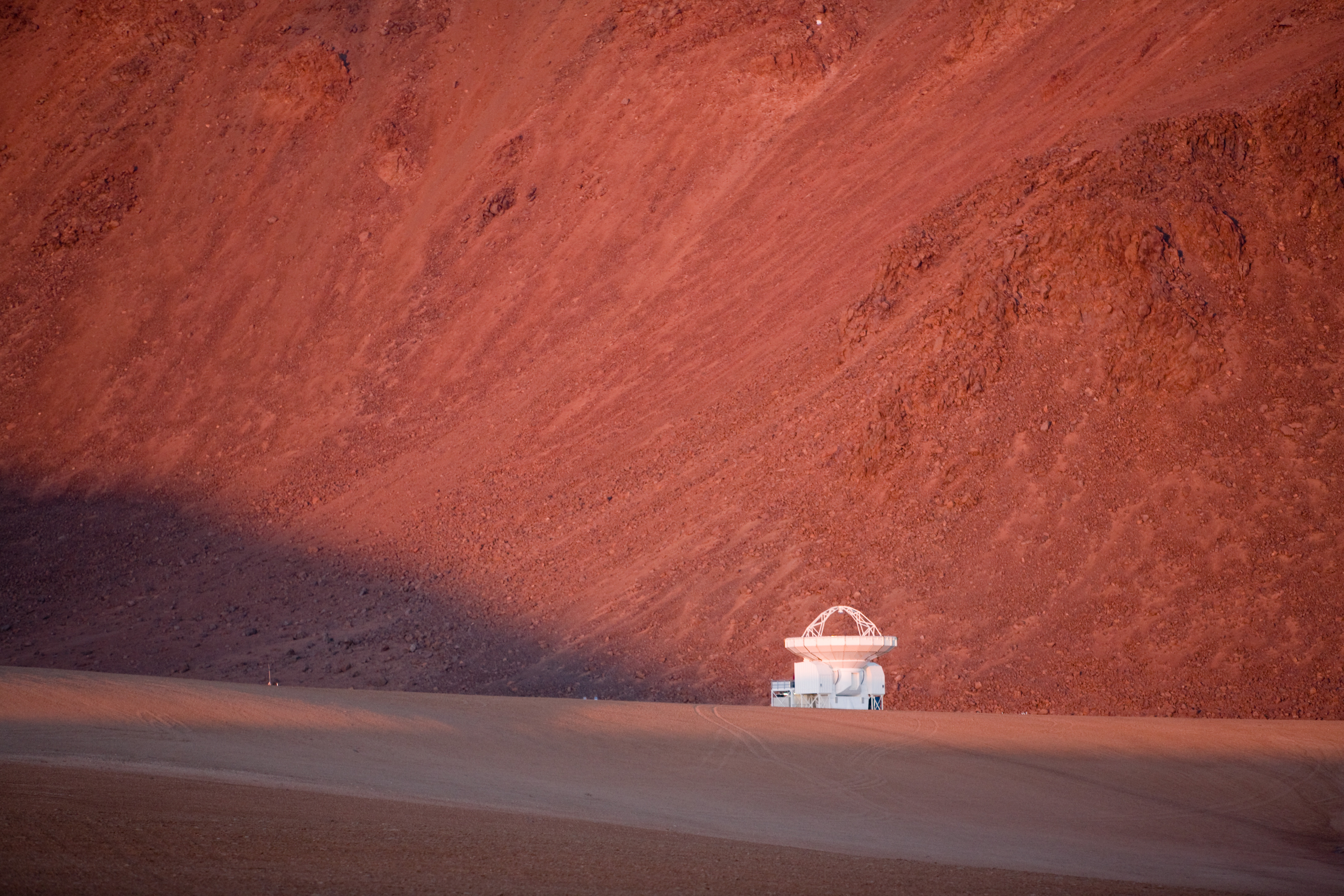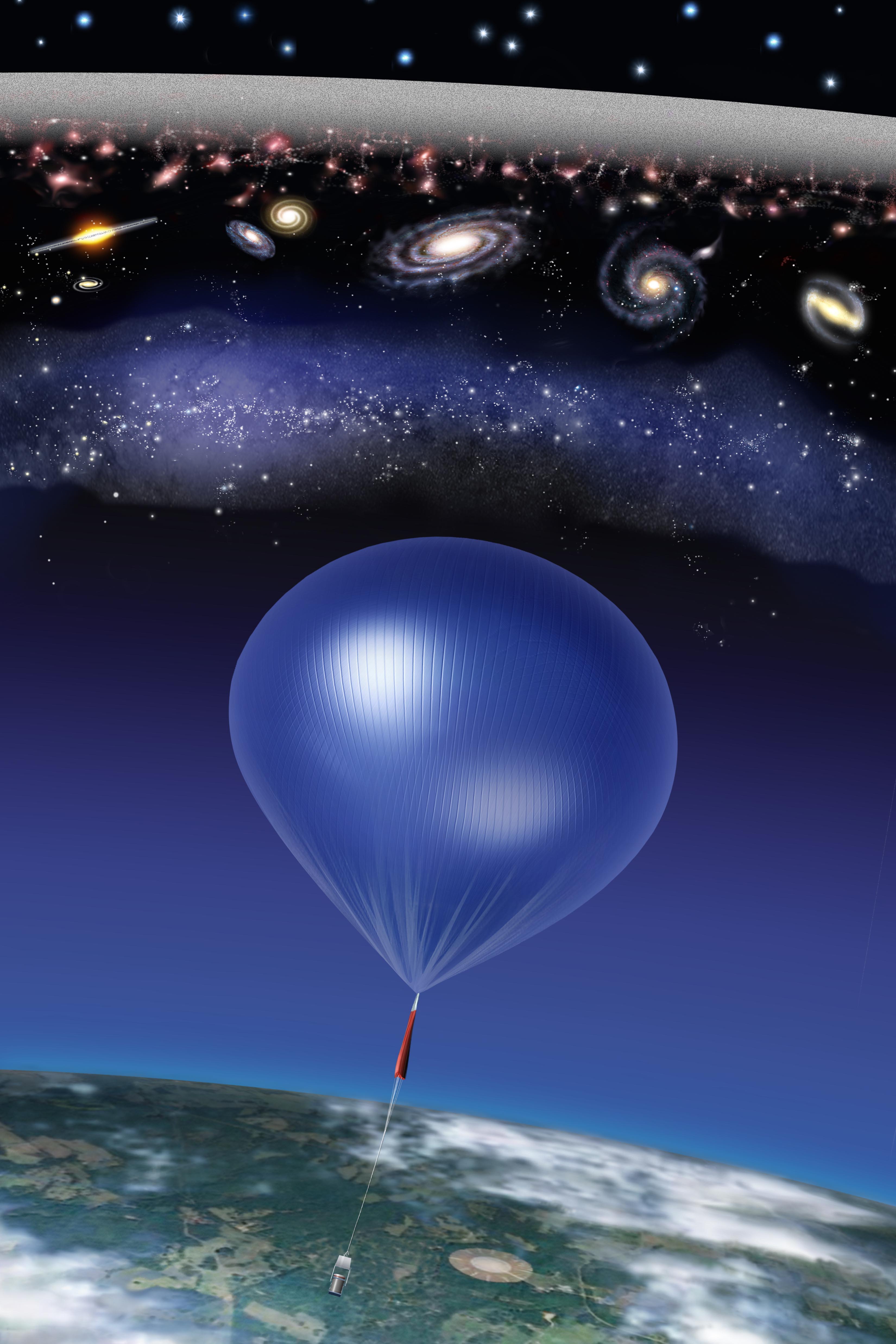|
POLARBEAR
POLARBEAR (POLARization of the Background Radiation) is a cosmic microwave background polarization experiment located in the Atacama Desert of northern Chile in the Antofagasta Region. The POLARBEAR experiment is mounted on the Huan Tran Telescope (HTT) at the James Ax Observatory in the Chajnantor Science Reserve. The HTT is located near the Atacama Cosmology Telescope on the slopes of Cerro Toco at an altitude of nearly . POLARBEAR was developed by an international collaboration which includes University of California, Berkeley, Lawrence Berkeley National Lab, University of Colorado at Boulder, University of California, San Diego, Imperial College, Astroparticle and Cosmology Laboratory of the University of Paris (2019), KEK (High Energy Accelerator Research Organization), McGill University, and Cardiff University. History The instrument was first installed at the Combined Array for Research in Millimeter-wave Astronomy site near Westgard Pass in California (USA) for an eng ... [...More Info...] [...Related Items...] OR: [Wikipedia] [Google] [Baidu] |
Cosmic Microwave Background
The cosmic microwave background (CMB, CMBR), or relic radiation, is microwave radiation that fills all space in the observable universe. With a standard optical telescope, the background space between stars and galaxies is almost completely dark. However, a sufficiently sensitive radio telescope detects a faint background glow that is almost isotropic, uniform and is not associated with any star, galaxy, or other astronomical object, object. This glow is strongest in the microwave region of the electromagnetic spectrum. The accidental Discovery of cosmic microwave background radiation, discovery of the CMB in 1965 by American radio astronomers Arno Allan Penzias and Robert Woodrow Wilson was the culmination of work initiated in the 1940s. The CMB is landmark evidence of the Big Bang scientific theory, theory for the origin of the universe. In the Big Bang cosmological models, during the earliest periods, the universe was filled with an Opacity (optics), opaque fog of dense, hot ... [...More Info...] [...Related Items...] OR: [Wikipedia] [Google] [Baidu] |
Brian Keating
Brian Gregory Keating (born September 9, 1971) is an American cosmologist. He works on observations of the cosmic microwave background, leading the POLARBEAR2 and Simons Array experiments. He also conceived the first BICEP experiment. He received his PhD in 2000, and is a distinguished professor of physics at University of California, San Diego, since 2019. He is the author of two books, ''Losing The Nobel Prize'' and ''Into the Impossible''. Education and career Keating received his B.S. degree in physics at Case Western Reserve University in 1993. He then obtained his M.S. and Ph.D. in physics at Brown University in 1995. His thesis, titled ''A search for the large angular scale polarization of the cosmic microwave background'' and supervised by Peter Timbie, was accepted in 2000. He started as a National Science Foundation (NSF) postdoctoral fellow at the California Institute of Technology in 2001 until 2004. He was an assistant professor at the University of California, ... [...More Info...] [...Related Items...] OR: [Wikipedia] [Google] [Baidu] |
Llano De Chajnantor Observatory
Llano de Chajnantor Observatory is the name for a group of astronomy, astronomical observatory, observatories located at an altitude of over 4,800 m (15,700 ft) in the Atacama Desert of northern Chile. The site is in the Antofagasta Region approximately 50 kilometres (31 mi) east of the town of San Pedro de Atacama. The exceptionally arid climate of the area is inhospitable to humans, but creates an excellent location for millimeter, submillimetre astronomy, submillimeter, and mid-infrared astronomy. This is because water vapour absorbs and attenuates submillimetre radiation. Llano de Chajnantor is home to the largest and most expensive astronomical telescope project in the world, the Atacama Large Millimeter Array (ALMA). Llano de Chajnantor and the surrounding area has been designated as the Chajnantor Science Reserve (Spanish: ''Reserva Científica de Chajnantor'') by the government of Chile. Site description The Llano de Chajnantor is located on the western ... [...More Info...] [...Related Items...] OR: [Wikipedia] [Google] [Baidu] |
Simons Observatory
The Simons Observatory is located in the high Atacama Desert in Northern Chile inside the Chajnator Science Preserve, at an altitude of 5,200 meters (17,000 ft). The Atacama Cosmology Telescope (ACT) and the Simons Array were located nearby but these instruments have now been replaced by the current (3 small-aperture telescopes and one large-aperture telescope) telescopes of the Simons Observatory. These instruments are currently making observations of the Cosmic Microwave Background (CMB). Their goals are to study how the universe began, what it is made of, and how it evolved to its current state. The Simons Observatory shares many of the same goals of the previous experiments but takes advantage of advances in technology to make far more precise and diverse measurements. In addition, it is envisaged that many aspects of the Simons Observatory (optical designs, detector technologies, and so on) will be pathfinders for the future CMB-S4 array. The Simons Observatory has bee ... [...More Info...] [...Related Items...] OR: [Wikipedia] [Google] [Baidu] |
LiteBIRD
''LiteBIRD'' (Lite (Light) satellite for the studies of B-mode polarization and Inflation from cosmic background Radiation Detection) is a planned small space observatory that aims to detect the footprint of the primordial gravitational wave on the cosmic microwave background (CMB) in a form of polarization pattern called B-mode. ''LiteBIRD'' and OKEANOS were the two finalists for Japan's second Large-Class Mission. [...More Info...] [...Related Items...] OR: [Wikipedia] [Google] [Baidu] |
Cosmic Microwave Background Experiments
This list is a compilation of experiments measuring the cosmic microwave background radiation, cosmic microwave background (CMB) radiation anisotropies and polarization since the first detection of the CMB by Arno Allan Penzias, Penzias and Robert Woodrow Wilson, Wilson in 1964. There have been a variety of experiments to measure the cosmic microwave background radiation, CMB anisotropies and polarization since its first observation in 1964 by Arno Allan Penzias, Penzias and Robert Woodrow Wilson, Wilson. These include a mix of ground-, balloon- and space-based receivers. Some notable experiments in the list are Cosmic Background Explorer, COBE, which first detected the temperature anisotropies of the CMB, and showed that it had a black body spectrum; Degree Angular Scale Interferometer, DASI, which first detected the polarization signal from the CMB; Cosmic Background Imager, CBI, which made high-resolution observations and obtained the first E-mode polarization spectrum; WMAP; ... [...More Info...] [...Related Items...] OR: [Wikipedia] [Google] [Baidu] |
Cerro Toco
Cerro Toco is a stratovolcano located in the eastern part of the Atacama Desert in Chile's II Region (Antofagasta), approximately south of the border between Bolivia and Chile and SE of the Juriques and Licancabur volcanoes. It conforms the north eastern extreme of the Purico Complex, a pyroclastic shield made up by several stratovolcanoes, lava domes and a maar. Cerro Toco is located in the Chajnantor Scientific Reserve, as is most of the Purico Complex. The Atacama Cosmology Telescope and the Huan Tran Telescope are located on the western side of the mountain at approximately . See also *List of volcanoes in Chile * Purico Complex *Licancabur * Juriques *Laguna Verde (Bolivia) *Andes The Andes ( ), Andes Mountains or Andean Mountain Range (; ) are the List of longest mountain chains on Earth, longest continental mountain range in the world, forming a continuous highland along the western edge of South America. The range ... References * * (Spanish) V ... [...More Info...] [...Related Items...] OR: [Wikipedia] [Google] [Baidu] |
Lawrence Berkeley National Lab
Lawrence Berkeley National Laboratory (LBNL, Berkeley Lab) is a Federally funded research and development centers, federally funded research and development center in the Berkeley Hills, hills of Berkeley, California, United States. Established in 1931 by the University of California (UC), the laboratory is sponsored by the United States Department of Energy and administered by the UC system. Ernest Lawrence, who won the Nobel prize for inventing the cyclotron, founded the lab and served as its director until his death in 1958. Located in the Berkeley Hills, the lab overlooks the campus of the University of California, Berkeley. Scientific research The mission of Berkeley Lab is to bring science solutions to the world. The research at Berkeley Lab has four main themes: discovery science, energy, earth systems, and the future of science. The Laboratory's 22 scientific divisions are organized within six areas of research: Computing Sciences, Physical Sciences, Earth and Environmenta ... [...More Info...] [...Related Items...] OR: [Wikipedia] [Google] [Baidu] |
University Of California, Berkeley
The University of California, Berkeley (UC Berkeley, Berkeley, Cal, or California), is a Public university, public Land-grant university, land-grant research university in Berkeley, California, United States. Founded in 1868 and named after the Anglo-Irish philosopher George Berkeley, it is the state's first land-grant university and is the founding campus of the University of California system. Berkeley has an enrollment of more than 45,000 students. The university is organized around fifteen schools of study on the same campus, including the UC Berkeley College of Chemistry, College of Chemistry, the UC Berkeley College of Engineering, College of Engineering, UC Berkeley College of Letters and Science, College of Letters and Science, and the Haas School of Business. It is Carnegie Classification of Institutions of Higher Education, classified among "R1: Doctoral Universities – Very high research activity". Lawrence Berkeley National Laboratory was originally founded as par ... [...More Info...] [...Related Items...] OR: [Wikipedia] [Google] [Baidu] |







